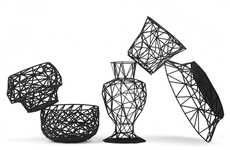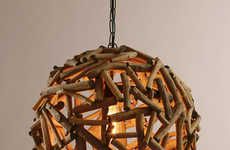
The Voronoi Birdcage Has a Texture More Stimulating than Metal Bars
Amelia Roblin — April 24, 2013 — Art & Design
References: cargocollective & design-milk
The criteria for designing a bird cage include many must-have features, yet these can be easily met by a design that isn't a strictly wireframe enclosure. The Voronoi Birdcage has been molded in a polymer material, incorporating areas of opacity and transparency while keeping your pet safely inside.
The organic and unpredictable pattern chosen for the walls of the prismic aviary was inspired by the forest canopies of entangled branches and patchy foliage. It creates perforations that are small enough to enclose the animals inside and large enough to see through. The fragmentary surfaces let light in in an intriguing way, just like your feathered friend might experience if seated on a bough in the woods. Melody Rees' whimsical Voronoi Birdcage integrates several perches and is produced in a playful bright blue.
The organic and unpredictable pattern chosen for the walls of the prismic aviary was inspired by the forest canopies of entangled branches and patchy foliage. It creates perforations that are small enough to enclose the animals inside and large enough to see through. The fragmentary surfaces let light in in an intriguing way, just like your feathered friend might experience if seated on a bough in the woods. Melody Rees' whimsical Voronoi Birdcage integrates several perches and is produced in a playful bright blue.
Trend Themes
1. Organic-inspired Animal Enclosures - Incorporating natural patterns and materials in animal enclosures presents an opportunity for designers to offer unique and visually appealing alternatives to traditional wireframe cages.
2. Light-permeable Pet Containment - Designing pet enclosures with perforations that allow light in creates innovative opportunities for pet owners to provide their pets with a more natural environment, and presents opportunities for material and technology advancements to maintain safety and durability.
3. Polymer Composites for Animal Habitats - Developing polymer-based materials specifically for animal habitats provides an opportunity for manufacturers to create lightweight, durable, and versatile structures that maintain the safety and comfort of the animal inhabitants.
Industry Implications
1. Pet Products - Incorporating designs inspired by the natural environment in pet enclosures, and developing materials specifically for animal habitats presents new opportunities for manufacturers and designers of pet products.
2. Architecture and Design - Designing innovative animal enclosures that integrate natural patterns and materials provides opportunities in the architectural and design industries, such as designing aviaries in public spaces, or high-end pet housing solutions.
3. Materials Science - Developing polymer-based materials specifically for animal habitats presents opportunities for research and development in materials science and can expand the use of polymer composites in other fields.
3.1
Score
Popularity
Activity
Freshness























